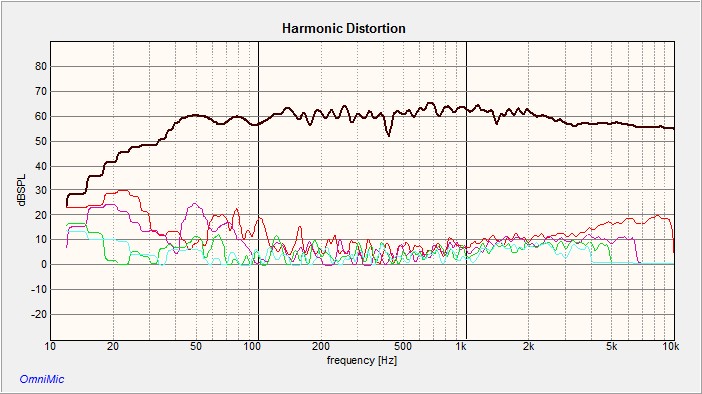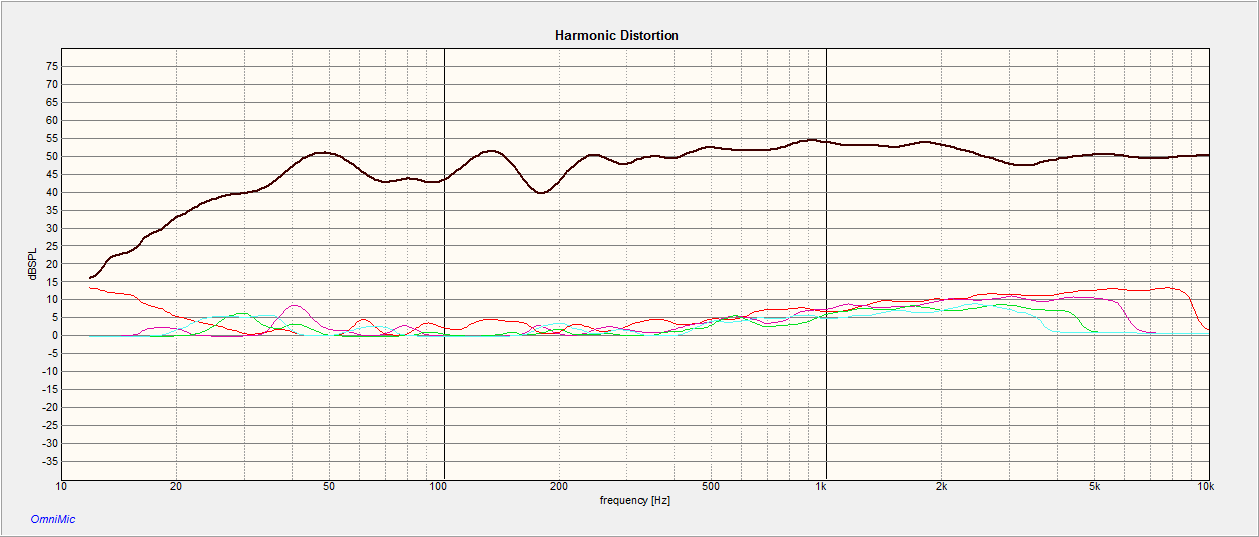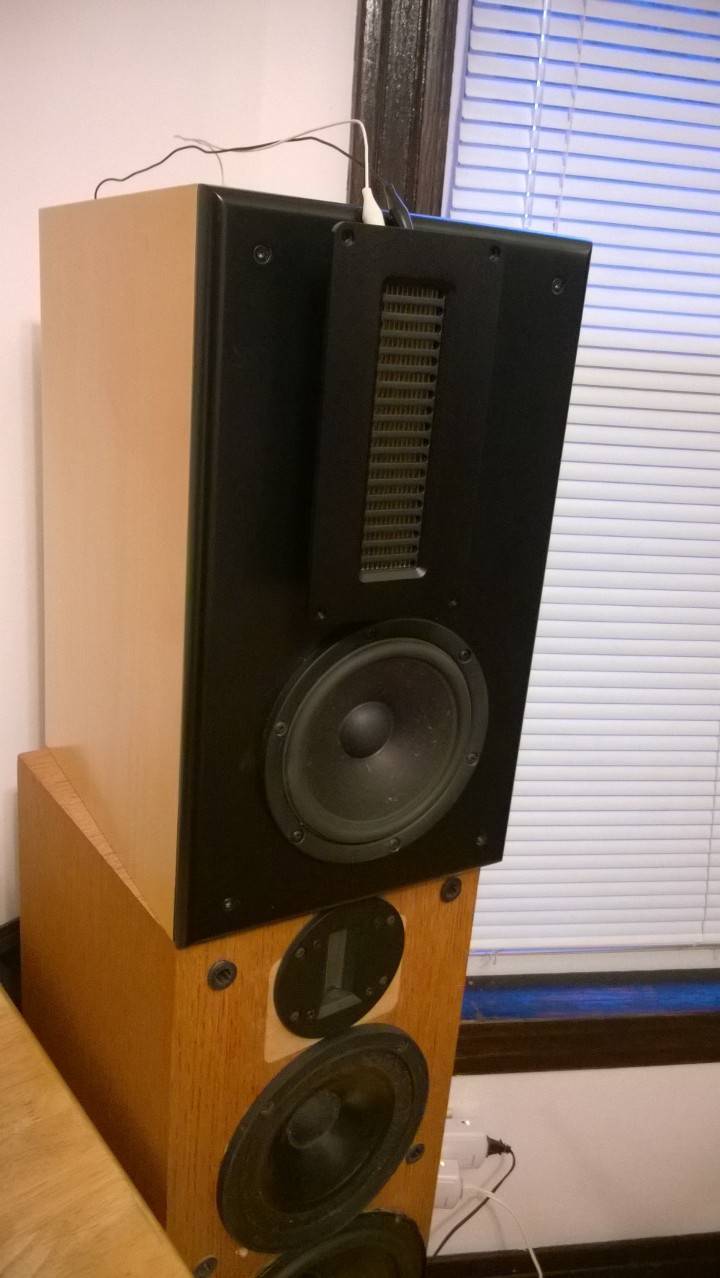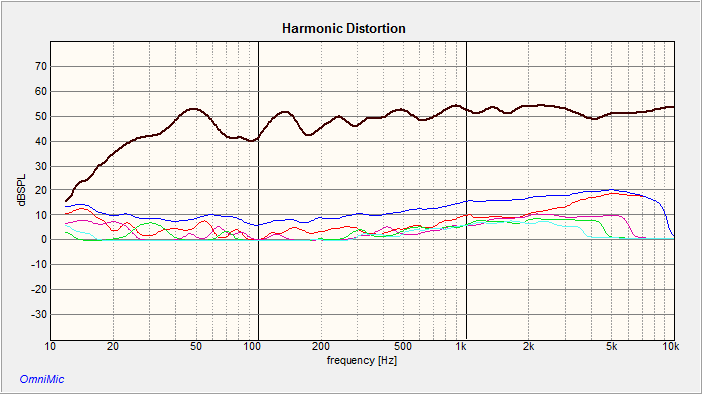
If you are using this 5" ribbon, what frequency are you crossing over at?
I'm playing around with an active (biamp) 2-way with a Satori 6.5" woofer and a Fountek NeoCD 2.0 ribbon.
I'm crossing over at 3 kHz / 48 dB per octave Linkwitz-Riley topology using a MiniDSP/MiniDIGI.
I have to say I'm not terribly happy with it so far. There's a lower treble / upper midrange roughness to the sound, even though the THD looks OK in the tests I've run...

Last edited:
I changed the crossover to 2250 Hz, and, in fact, it did sound BETTER. You are right, I was trying to use the Satori up too high.
2250 is too low for this tweeter, distortion in the lower part of the treble will get ugly at anything approaching loud. However, as a test, changing the crossover down lower did prove that the problems were coming from the Satori approaching it's breakup and having a funky radiation pattern at so high a frequency.
Here's FR and harmonic distortion curves with a 2250 xover

This is a bi-amp project so a midrange driver - like a Morel MDM55- is really not an option. None of the Fountek ribbons will work low enough in frequency; I'm told the Raal 140-15D ribbons will, but they're quite costly. I might just pry the wallet open and spring for some Raal ribbons, I've wanted to use them in a project since I heard about them... but still... $630 each.... wow.
Maybe I'll try one of the larger Dayton AMT tweeters, like the AMT 3-4. $200 a pair. Or maybe the Dayton AMT Pro-4 which is $300 a pair and better down below 3 kHz. Or maybe the Aurum Cantus AST2560, $340 a pair. Ribbons they are not, but they should work down to 2 kHz. (I could use some kind of dome or ring, but I am bored with domes.)
There is also the Aurum Cantus G3 ribbon which they claim will work down to 2300 Hz. I dunno. I have a feeling it will have the same kinds of distortion issues that the Fountek has. And, they are not cheap -$420 a pair.
2250 is too low for this tweeter, distortion in the lower part of the treble will get ugly at anything approaching loud. However, as a test, changing the crossover down lower did prove that the problems were coming from the Satori approaching it's breakup and having a funky radiation pattern at so high a frequency.
Here's FR and harmonic distortion curves with a 2250 xover

This is a bi-amp project so a midrange driver - like a Morel MDM55- is really not an option. None of the Fountek ribbons will work low enough in frequency; I'm told the Raal 140-15D ribbons will, but they're quite costly. I might just pry the wallet open and spring for some Raal ribbons, I've wanted to use them in a project since I heard about them... but still... $630 each.... wow.
Maybe I'll try one of the larger Dayton AMT tweeters, like the AMT 3-4. $200 a pair. Or maybe the Dayton AMT Pro-4 which is $300 a pair and better down below 3 kHz. Or maybe the Aurum Cantus AST2560, $340 a pair. Ribbons they are not, but they should work down to 2 kHz. (I could use some kind of dome or ring, but I am bored with domes.)
There is also the Aurum Cantus G3 ribbon which they claim will work down to 2300 Hz. I dunno. I have a feeling it will have the same kinds of distortion issues that the Fountek has. And, they are not cheap -$420 a pair.
OK so I ordered a pair of Dayton Audio AMTPRO-4, http://www.parts-express.com/pedocs/specs/275-094s.pdf
We'll see how that sounds. This is an experiment...
I had the Fountek NeoCD 2.0's laying around, and thought I'd try them...they are good used at higher frequencies, but I need to cross over around 2,000~2,500 Hz. I think these AMT's ought to work well down to that range, but they're not going to have the fast settling times etc of an actual ribbon. Maybe that will work to their advantage, though - maybe their overall characteristics will blend better with the Satori 6.5" woofers.
We will see.
We'll see how that sounds. This is an experiment...
I had the Fountek NeoCD 2.0's laying around, and thought I'd try them...they are good used at higher frequencies, but I need to cross over around 2,000~2,500 Hz. I think these AMT's ought to work well down to that range, but they're not going to have the fast settling times etc of an actual ribbon. Maybe that will work to their advantage, though - maybe their overall characteristics will blend better with the Satori 6.5" woofers.
We will see.
Dayton AMTPRO-4's arrived. Just temporarily hung them on the front of the speakers and ran some curves....
The new 2-way project is perched on top of a floor standing project that is dormant at the moment, ignore that

Initial curve; blue is THD, red is 2nd harmonic, etc
Crossover is 1800 Hz 48 db / octave L-R

These Dayton AMTPRO-4's are rated 94 dB /1m / 1 watt, but I think that's a bit optimistic.
The sound was quite different from the Fountek ribbon. There was more detail in the mids / lower treble, although I think the Fountek has a little better upper treble "bite" and extension. Even so, the AMT sounded more realistic in this application than the Fountek ribbon, mostly I think because it could be crossed over lower. Also, I think the AMT is a bit more "dynamic" in the lower treble. MUCH more listening and testing is needed.
FYI I am using a very small (~1 watt) S.E. tube amp to drive the tweeters, and this amp is not adequate to drive the AMT's; the slight rise in THD above the crossover point is due to the amplifier. The Fountek ribbons were about 4~5 dB more sensitive and the little tube amp could drive them nicely; these AMTs want a bit more power. I am finishing up a small class A solid state amp that I will use for the AMT, I'll plot some more curves once I finish that and I expect the THD to be lower with that amplifier.
I have also ordered a pair of ribbon tweeters from Selah Audio, and Rick at Selah says they have low distortion and can be used down to 1800 Hz. I will try those as well, once they arrive.
With these AMTs and the ribbons from Selah, I will have to pick one or the other for these two-ways. The driver I DON'T use here will later go into another speaker project that's languishing in my workshop...
The new 2-way project is perched on top of a floor standing project that is dormant at the moment, ignore that

Initial curve; blue is THD, red is 2nd harmonic, etc
Crossover is 1800 Hz 48 db / octave L-R

These Dayton AMTPRO-4's are rated 94 dB /1m / 1 watt, but I think that's a bit optimistic.
The sound was quite different from the Fountek ribbon. There was more detail in the mids / lower treble, although I think the Fountek has a little better upper treble "bite" and extension. Even so, the AMT sounded more realistic in this application than the Fountek ribbon, mostly I think because it could be crossed over lower. Also, I think the AMT is a bit more "dynamic" in the lower treble. MUCH more listening and testing is needed.
FYI I am using a very small (~1 watt) S.E. tube amp to drive the tweeters, and this amp is not adequate to drive the AMT's; the slight rise in THD above the crossover point is due to the amplifier. The Fountek ribbons were about 4~5 dB more sensitive and the little tube amp could drive them nicely; these AMTs want a bit more power. I am finishing up a small class A solid state amp that I will use for the AMT, I'll plot some more curves once I finish that and I expect the THD to be lower with that amplifier.
I have also ordered a pair of ribbon tweeters from Selah Audio, and Rick at Selah says they have low distortion and can be used down to 1800 Hz. I will try those as well, once they arrive.
With these AMTs and the ribbons from Selah, I will have to pick one or the other for these two-ways. The driver I DON'T use here will later go into another speaker project that's languishing in my workshop...
Last edited:
How dumb is it to use a tweeter with a vertically aligned radiation pattern with a standard woofer?
This tweeter is best used in an MTM. Seemples. Then the radiation of the woofers and tweeter falls off similarly with distance. You guys are so dumb. Sorry.
Not applicable to nearfield use.
Here's another speaker I built, designed for normal room type listening rather than nearfield use:
An externally hosted image should be here but it was not working when we last tested it.
Last edited:
greetings,
Are you using an in-line, series capacitor to the ribbon (or driver of your choice) ?
Use a value that will give an Fcx at one octave lower than what your active crossover does. This offers a startling increase in clarity.
That's interesting. No, I don't have a capacitor in series with the AMT. I assumed that since I am using a tube amplifier (transformer coupled...) there was no risk of DC on the output... and in my case, due to the poor LF performance of the tiny amplifier, no risk of bass either....
I'll give it a try. I have a bunch of good quality film caps laying around of various large values.
How dumb is it to use a tweeter with a vertically aligned radiation pattern with a standard woofer?
This tweeter is best used in an MTM. Seemples. Then the radiation of the woofers and tweeter falls off similarly with distance. You guys are so dumb. Sorry.
How do you explain this?
1. SILK - home
2. Lineup ? Selah Audio
There are few others I have come across. The question is, are the designers dumb or the consumers?
Last edited:
It's hard to explain unless you are extremely savvy about dispersion in loudspeakers. At heart, a vertical ribbon line-array tweeter in an MTM falls off as inverse distance, illustrated here, as do the twin mid-basses:
Single spherically symmetrical drivers fall off as inverse square. If I was using single spherical drivers, I would use an MTTM arrangement. That's it really.
BTW, a proper bass unit near the floor behaves as a twin bass due to reflection. You must, in your mind, see the reflection off the floorboards to properly get it. You cross over at the bafflestep point. If we allow for the Allison effect, this is a flippin' wonderful speaker IMO!
An externally hosted image should be here but it was not working when we last tested it.
Single spherically symmetrical drivers fall off as inverse square. If I was using single spherical drivers, I would use an MTTM arrangement. That's it really.
BTW, a proper bass unit near the floor behaves as a twin bass due to reflection. You must, in your mind, see the reflection off the floorboards to properly get it. You cross over at the bafflestep point. If we allow for the Allison effect, this is a flippin' wonderful speaker IMO!
Last edited:
How do you explain this?
1. SILK - home
2. Lineup ? Selah Audio
There are few others I have come across. The question is, are the designers dumb or the consumers?
Here is the correct link,
Gallery ? Selah Audio
But a beautiful speaker nevertheless, isn't it?

Go on, agree for a change! Actually I would have put the woofer nearer the front to get phase aligned, milosz, but not too important IMO. Lovely work!
An externally hosted image should be here but it was not working when we last tested it.
Go on, agree for a change! Actually I would have put the woofer nearer the front to get phase aligned, milosz, but not too important IMO. Lovely work!
Last edited:
Hi,
To rub it in more designs here:
Alta Audio FRM-2 Speakers – Reviews | TONEAudio MAGAZINE
Philharmonic Audio
To rub it in more designs here:
Alta Audio FRM-2 Speakers – Reviews | TONEAudio MAGAZINE
Philharmonic Audio
There are two 10" woofers, one on each side of the lower portion of the cabinet. Due to the narrow cabinet they are not placed magnet-to-magnet, they don't fit, so they are offset- on one side the driver is closer to the front.
The crossover to the woofers is 100 Hz, 48 dB per octave. Sound at 100 Hz has a wavelength of 3.4 meters = 3400 cm (11.25 feet) - do you REALLY think that moving the driver 100 cm is going to make an audible difference in "time alignment?"
I am going to be changing the tweeter in these speakers. The Fountek doesn't go low enough for a good crossover to those SEAS drivers. I will be using the Selah ribbon tweeter, I think; or maybe the Dayton AMTPRO-4. I have ordered the Selah ribbon and I have on hand the Dayton AMT, so I can experiment and pick which is best. I will do that later on- right now I conducting experiments with the 2-way based on the Satori 6.5" woofer, trying the various tweeters. My next step is to finish building the small class A Nelson Pass DIY "Zen" amp to drive the tweeters, the little single-ended tube amp I was using doesn't have enough power for the Dayton AMT or the Selah ribbon. The Fountek ribbon is 97 dB @ 1 watt @ 1 meter, whereas the Dayton AMT is rated 94 dB, and from my initial measurements I'd say that 94 is optimistic- I'd rate it more at about 92 dB. Rick at Selah says his ribbon is 90 dB, I am guessing that 90 will be accurate, he knows his stuff. The little Zen amp ought to be OK with either driver.
Actually what I mostly listen to is a pair of Magneplanar MG 3.6's tri-amped using a DEQX, with subwoofers added below 45 Hz using a different crossover. I also listen quite a lot to my Quad ESL-57's, on an H-K Citation II; no subwoofer there.
These little 2-ways are for my bedroom; the big 3-ways in the picture were once my main speakers before the MG 3.6's, and, really, I have no place to use them.... they are usually stored, but I do drag them out and listen once in a while. Building things is the fun part, for me.
The crossover to the woofers is 100 Hz, 48 dB per octave. Sound at 100 Hz has a wavelength of 3.4 meters = 3400 cm (11.25 feet) - do you REALLY think that moving the driver 100 cm is going to make an audible difference in "time alignment?"
I am going to be changing the tweeter in these speakers. The Fountek doesn't go low enough for a good crossover to those SEAS drivers. I will be using the Selah ribbon tweeter, I think; or maybe the Dayton AMTPRO-4. I have ordered the Selah ribbon and I have on hand the Dayton AMT, so I can experiment and pick which is best. I will do that later on- right now I conducting experiments with the 2-way based on the Satori 6.5" woofer, trying the various tweeters. My next step is to finish building the small class A Nelson Pass DIY "Zen" amp to drive the tweeters, the little single-ended tube amp I was using doesn't have enough power for the Dayton AMT or the Selah ribbon. The Fountek ribbon is 97 dB @ 1 watt @ 1 meter, whereas the Dayton AMT is rated 94 dB, and from my initial measurements I'd say that 94 is optimistic- I'd rate it more at about 92 dB. Rick at Selah says his ribbon is 90 dB, I am guessing that 90 will be accurate, he knows his stuff. The little Zen amp ought to be OK with either driver.
Actually what I mostly listen to is a pair of Magneplanar MG 3.6's tri-amped using a DEQX, with subwoofers added below 45 Hz using a different crossover. I also listen quite a lot to my Quad ESL-57's, on an H-K Citation II; no subwoofer there.
These little 2-ways are for my bedroom; the big 3-ways in the picture were once my main speakers before the MG 3.6's, and, really, I have no place to use them.... they are usually stored, but I do drag them out and listen once in a while. Building things is the fun part, for me.
Last edited:
I can only go by what I see.There are two 10" woofers, one on each side of the lower portion of the cabinet. Due to the narrow cabinet they are not placed magnet-to-magnet, they don't fit, so they are offset- on one side the driver is closer to the front.
The crossover to the woofers is 100 Hz, 48 dB per octave. Sound at 100 Hz has a wavelength of 3.4 meters = 3400 cm (11.25 feet) - do you REALLY think that moving the driver 100 cm is going to make an audible difference in "time alignment?"
An externally hosted image should be here but it was not working when we last tested it.
A lovely speaker, IMO, milosz. Well below the Allison Effect, which in simple terms describes destructive cancellation by the nearest room boundary. You are a clever man. The best speaker I have ever seen at diyaudio.
Last edited:
Yes a vertical tweeter is similar in pattern to MTM alignment, but these things only matter when you are listening at some distance. Used as nearfield speakers, it's moot. One has to be careful to "aim" the speakers at the nearfield listener properly, to be in the correct relationship between ear, tweeter and mid-woofer, but the whole falling off as square of distance or falling off as twice the distance doesn't matter if distance between speaker and ear is small.
I can only go by what I see.

A lovely speaker, IMO, milosz. Well below the Allison Effect, which in simple terms describes destructive cancellation by the nearest room boundary. You are a clever man. The best speaker I have ever seen at diyaudio.
Well thank you for the compliment. Most kind of you.
I think they look better than they sound.... they're good, and will be better with new tweeters, but they're not great.
- Status
- This old topic is closed. If you want to reopen this topic, contact a moderator using the "Report Post" button.
- Home
- Loudspeakers
- Multi-Way
- Anyone using Fountek NeoCD 2.0 5" ribbons?